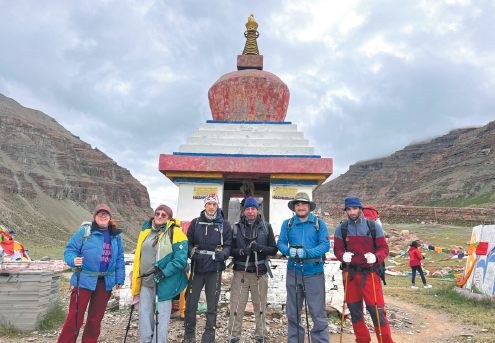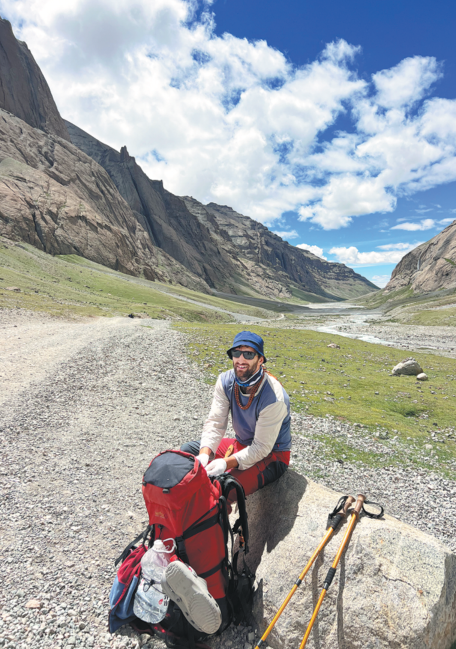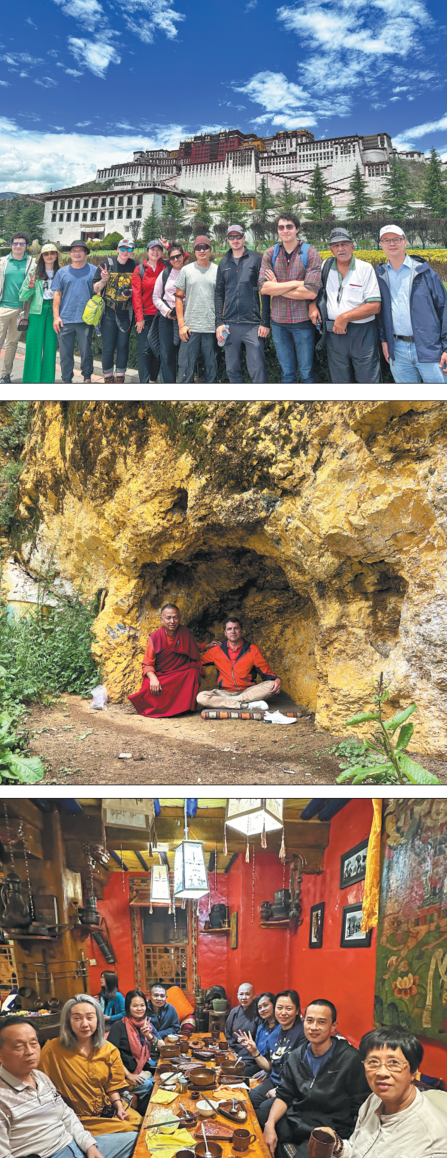Overseas travelers rejoicing at revisiting majestic Tibet
Updated: 2023-09-21 (China Daily)  Print
Print 


Autonomous region sees inbound tourism begin to recover and flourish after end of COVID-19 restrictions
After hearing the news that Tibet would reopen to foreign tourists earlier this year, All Ways International, a United States-based travel agency, wasted no time in putting advertisements on its social media platforms and in contacting clients.
The company organized its first group of 11 foreign travelers for a tour of the autonomous region in Southwest China in late May.
The tour group was made up of mostly Russians and people from other European countries, according to Vladimir Poda, a Russian who works as an organizer of tourist groups for the company.
Poda's first tour of Tibet was in 2013, with a group of around 20 people, mostly Russian speakers from several countries. He has visited Tibet eight times in the past decade.
"Due to the COVID-19 pandemic, many foreign travelers had to cancel their plans to visit Tibet in the past three years, and some have been eager to tour the region," Poda said.
Tibet suspended inbound tourism in February 2020, in accordance with the policies of China's Ministry of Culture and Tourism that were aimed at curbing the spread of the COVID-19 pandemic.
There has been an influx of foreign travelers into Tibet since the autonomous region reopened to the outside world in April and more than 13,000 foreign tourists visited in July, an increase of 358 percent year-on-year.
The autonomous region's revenue generated from international tourists exceeded $11 million in the first half of 2023, up 364 percent from the same period in 2022, according to Tibet's tourism development department.
As Chinese visas have become more easily accessible, more overseas tourists have chosen to travel to China.
Data from the local tourism development department in Tibet show the autonomous region attracted more than 11,000 foreign tourists and had total revenue of more than $78 million from overseas travelers in 2019, a rise of 53 percent and 44 percent respectively on 2018.
"Currently, the number of inbound tourists from Nepal visiting Tibet has reached the same level with the figure in pre-pandemic 2019, but the number of inbound tourists from other countries and regions is smaller than that before the pandemic," said Dekyi, an official in the autonomous region's tourism department, who added that overseas tourists visiting Tibet this year hailed from more than 70 countries, including Nepal, the US, Malaysia, Vietnam, Germany, Japan and the United Kingdom.
"Most overseas tourists like to tour places with unique features of Tibetan culture, such as the cities of Lhasa, Shigatse and Lhokha, as well as Ngari prefecture," Dekyi said.
She added that overseas travelers have to make an application to visit Tibet after they have attained a Chinese visa. The application processing time for a trip to Tibet has been cut to about three days, from more than one week before 2020.
"Our department has been coordinating with other departments to build a platform to supervise the autonomous region's inbound tourism," Dekyi said.
She called the platform a "breakthrough" that has helped the local authorities significantly shorten the time needed to process foreign tourists' applications for a tour of the autonomous region.
"It has effectively helped inbound travel agencies to get approvals," she added.
Fast growth
Yang Yong, general manager of Tibet Vista Tour, an international travel agency that provides tourism services for both inbound and domestic tourists to Tibet, said his company expects to offer services to about 2,000 overseas travelers this year. He said most of the overseas travelers visiting Tibet are foreigners who work and live in other parts of China.
"The proportion of overseas tourists who made trips to the region from outside China is relatively small," Yang said. "Most overseas travelers that my company received this year are mainly from Europe, America, and Southeast Asian countries."
Yang said his company expects that this year it can receive about 8,000 overseas tourists, or 25 percent of the figure in 2019, because the recovery of flights into the region has been relatively slow.
"Most overseas tourists have a positive impression about touring Tibet, but some are unhappy with the toilets at the tourism sites," he said.
Yang said his company provides services to help with hotel reservations, food, transportation, tickets, tour guides, and document processing.
He said foreign tourists like to see Mount Qomolangma in the Tibetan city of Shigatse, and they also like to go to western Tibet's Ngari prefecture, and to the scenic routes that link with attractions in Nepal.
More income for insiders
Jamyang Tsering, a Tibetan tour guide who speaks German and English at Tibet Vista Tour, said that, with the number of overseas tourists rising this season, his monthly income has doubled.
Before April, he was earning an average of 6,000 yuan ($825) a month, but his income has now increased to more than 13,000 yuan, thanks to the influx of foreign travelers.
Jamyang Tsering said overseas tourists feel safe traveling in Tibet, and that they like the local food, which always has multiple options available.
"I have also found that many overseas tourists are really surprised at the overall development of the region, and many did not expect that much development before they came," said Jamyang Tsering, who added that most Western tourists love to visit Mount Kailash, the Potala Palace and the ruins of Guge Kingdom founded in around 912 AD by Kyide Nyima Gon, the great-grandson of the Tibetan king Langdarma, with its capital in Purang, more than 1,500 kilometers from Lhasa.
"Some guests are more interested in religious cultures of the region, such as the Drigungthil Monastery, and others prefer to go to rural places to see how local people live, dress and practice their religion," he said.
Due to the COVID-19 pandemic, inbound tourism was suspended for three years and after the reopening, many foreign guests were very excited to have the opportunity to visit the region again, Jamyang Tsering added.
Choedhar, a bilingual tour guide in Lhasa, said the number of overseas tourists has been increasing since April, especially the number of foreign tourists who work or live in other parts of China.
"For me, I served many European travelers this year, and I have found that many of them are more interested in the Tibetan traditional culture rather than just sightseeing," said Choedhar. "The autonomous region has been making efforts to make it easier for overseas tourists to visit Tibet. Now, most foreign tourists can visit the region only if they can get their travel documents, and they can find the right tour guides who speak their languages."
Spiritual culture
Poda, of All Ways International, said his travel agency has brought almost the same number of foreign tourists to Tibet this season as it did in 2019.
The most recent group Poda organized arrived in the autonomous region on Aug 8.
He said he took the opportunity to meet business partners in Lhasa, to revitalize their cooperation and to guide a group tour of the region.
The group of 21 tourists hailed mostly from Russia and Europe and was divided into two groups, with one guided by a Tibetan who speaks Tibetan and English, and the other guided by Poda, who speaks English and Russian.
"We visited the Potala Palace, the Jokhang Temple and the Drakyerpa Monastery … and we also visited a Tibetan village to get a glimpse of local people's life," he said. "What I like the most are the Jokhang Temple and the Potala Palace in Lhasa. I like them very much."
Poda added that he prefers to stay in simple hotels, rather than in fancy ones, as long as they have good locations, from which he can observe the ancient cultures of Tibet.
"We just visited Drakyerpa, where there are many meditation caves, which meant a lot for me, because I practice meditation and yoga," he said. "I also like to pay homage to the sacred Mount Kailash as the Tibetans and the Indians do."
Pilgrims from several religions believe that circumambulating Mount Kailash on foot is a holy ritual that will bring good fortune.

Tourists from overseas gather in June at the foot of Mount Kailash, or Mount Gangrinpoche as it is called in the Tibetan language, in Ngari prefecture, Tibet autonomous region. CHINA DAILY

An overseas tourist sorts through his backpack before approaching Mount Kailash. CHINA DAILY

From top: Foreign tourists pose for a photo before visiting the famed Potala Palace in Lhasa, the capital city of the Tibet autonomous region. Russian tourist Vladimir Poda practices meditation along with a Buddhist monk at the Drakyerpa Monastery near Lhasa. Some overseas and domestic tourists have a meal in a Tibetan restaurant in Lhasa in May. CHINA DAILY








